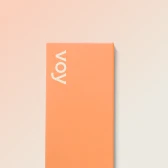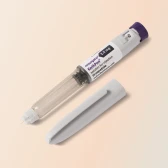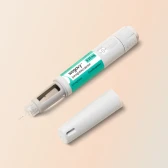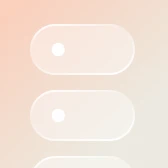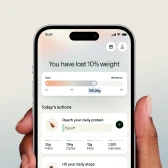GLP-1 medicines such as semaglutide and tirzepatide are now widely used for weight loss and type 2 diabetes. You may know them by their brand names: Ozempic and Wegovy (semaglutide), and Mounjaro (tirzepatide).
Like all medicines, GLP-1s can cause side effects, though most are mild and temporary. But recent headlines have raised questions about their impact on the eyes, from short-lived blurred vision to very rare eye conditions.
Here’s what we know so far and what this might mean for you.
Are GLP-1s linked to vision problems?
The short answer: Serious eye side effects are rare in people taking GLP-1s like Wegovy and Mounjaro.
The longer answer: Most people using weight loss injections don’t have lasting vision problems, though some do notice temporary blurred vision in the first weeks of their treatment plan. This can be due to the medication’s effect on blood sugar, and usually improves as your body gets used to the treatment.
GLP-1s can also reduce your thirst cues, as well as your appetite, so you might drink less without realising. Dehydration can dry the eyes, which can lead to blurry vision too. So remember to sip water regularly when you first start taking weight loss injections. It’s worth keeping preservative-free lubricating eye drops on hand as well.
For people with type 2 diabetes, existing diabetic retinopathy can sometimes flare when their blood sugar improves quickly. This isn’t unique to GLP-1s; it can happen with many other effective diabetes treatments.
Headlines about “Wegovy vision loss” or “Mounjaro vision” usually refer to rare conditions still under investigation, such as NAION (non-arteritic anterior ischemic optic neuropath—a type of optic nerve problem) and wet AMD, a serious form of age-related macular degeneration. We’ll go into more detail about both conditions in a sec.
What eye problems are being reported with GLP-1s?
While serious eye side effects are rare, researchers have been paying closer attention to certain conditions in people taking GLP-1 medicines. Most users will never experience these issues, but it helps to know what’s being studied and the signs to look out for.
Diabetic retinopathy (in people with diabetes):
Diabetic retinopathy is damage to the retina’s tiny blood vessels caused by long-term high blood sugar. These vessels can leak or swell, which may blur or distort your vision. Regular eye checks can spot changes early, and treatment can protect your sight.
What we know so far:
- In a Wegovy trial with people who have type 2 diabetes, diabetic retinopathy was reported in 4.0% of patients taking semaglutide vs 2.7% on placebo. In the patient information leaflet, “diabetic retinopathy in patients with type 2 diabetes” is classed as common (that means it can occur in at least 1 in 100 people with diabetes who use Wegovy).
- In trials for Mounjaro, new retinopathy events were ≤1%, but many people with moderate or severe retinopathy weren’t included in the study. Regular eye checks are still really important if you already have eye problems related to diabetes.
Non-arteritic anterior ischemic optic neuropathy (NAION)
NAION is a rare optic nerve problem leading to a sudden, usually painless loss of vision in one eye caused by reduced blood flow to the optic nerve.
What we know so far:
- In June 2025, European medicine regulators concluded that NAION is a very rare side effect of semaglutide.
- A specialist eye clinic reported more NAION diagnoses in people prescribed semaglutide than in matched patients on other medicines. But because these were referred patients (they’d already been sent to an eye clinic), the numbers don’t reflect everyday users and don’t prove that semaglutide causes NAION.
- A large study of 159,398 people with type 2 diabetes found NAION in 0.04% of GLP-1 users vs 0.02% of people on other diabetes medicines over two years. The absolute risk was still very low.
Neovascular age-related macular degeneration (wet AMD)
Neovascular age-related macular degeneration (nAMD, often called wet AMD) is an age-related change where tiny new vessels form under the retina and can leak. It can blur or distort central vision, but it’s treatable and many do well with prompt anti-VEGF eye injections from an eye specialist.
What we know so far:
- A 2025 study followed 139,002 older adults with diabetes. Wet AMD was diagnosed in 0.2% of GLP-1 users vs 0.1% of non-users. Because this was a retrospective study, it can’t prove GLP-1s cause wet AMD. The difference was very small—about 1 extra case per 1,000 people.
Eye problems and GLP-1s: What do you need to know?
For most people, GLP-1 medicines remain safe and beneficial, and the chance of a serious eye complication is low. The bigger picture is that GLP-1 treatments can actually benefit long-term eye health by helping to improve your metabolic health.
The advice differs slightly depending on whether you have diabetes or an existing eye disease.
If you don’t have diabetes: Serious GLP-1 eye side effects remain rare. There is no need for special eye appointments. Just keep your routine eye checks as normal.
If you have type 2 diabetes: Let your provider know and tell your doctor you’re starting a GLP-1—they may plan a blood test (e.g., HbA1c) in around 3 months. Keep up with your regular diabetic eye screening and report any vision changes early.
If you have diabetes with known eye disease (such as retinopathy or macular oedema): Speak to your eye clinic before starting a GLP-1. Your specialist will discuss what's right for you and may suggest a baseline exam and closer follow-up in the first months.
What to do if you notice eye symptoms on Wegovy or Mounjaro
If you’re taking a GLP-1 like Wegovy or Mounjaro and notice any changes in your vision, you might need to see a health professional urgently.
Seek same-day urgent care (Eye Emergency Dept or NHS 111) if you have:
- Sudden vision loss or worsening of vision
- A dark curtain/shadow, new flashes or a shower of floaters
- Severe eye pain or vision loss with headache/nausea
Book an urgent optician/eye clinic (within 24–48 hours) if you have:
- Vision that’s worsening over hours to days (including harder to see in low light)
- Persistent new blurring that doesn’t settle after a few days
Once you’ve arranged eye care, let your GLP-1 provider know. They may advise you to pause further doses until you’ve been assessed.
Your weight loss journey
GLP-1 medicines like Wegovy and Mounjaro have transformed diabetes and weight management for many people. While some research has raised questions about rare eye complications, the overall risk is very low.
Through our weight loss programme, you’ll get one-to-one support from our team of clinicians and coaches. They’ll check in with you on the regular, and help you keep tabs on any symptoms you’re experiencing so you can get any help you need asap. You can speak directly to Voy’s clinicians in-app, or call 020 3912 9885 (Mon–Sun, 9am–5pm) for tailored advice and side-effect support.
Side effects support at Voy
"If you're using Voy and you experience any side effects, rest assured that our expert clinicians are just a message or phone call away. They can adjust your dose, prescribe medication to ease your symptoms, or simply offer reassurance.
Everyone responds differently to weight loss treatment and we'll help you find what feels right for you."

Find out if you’re eligible for our science-backed weight loss programme by taking this short quiz.
